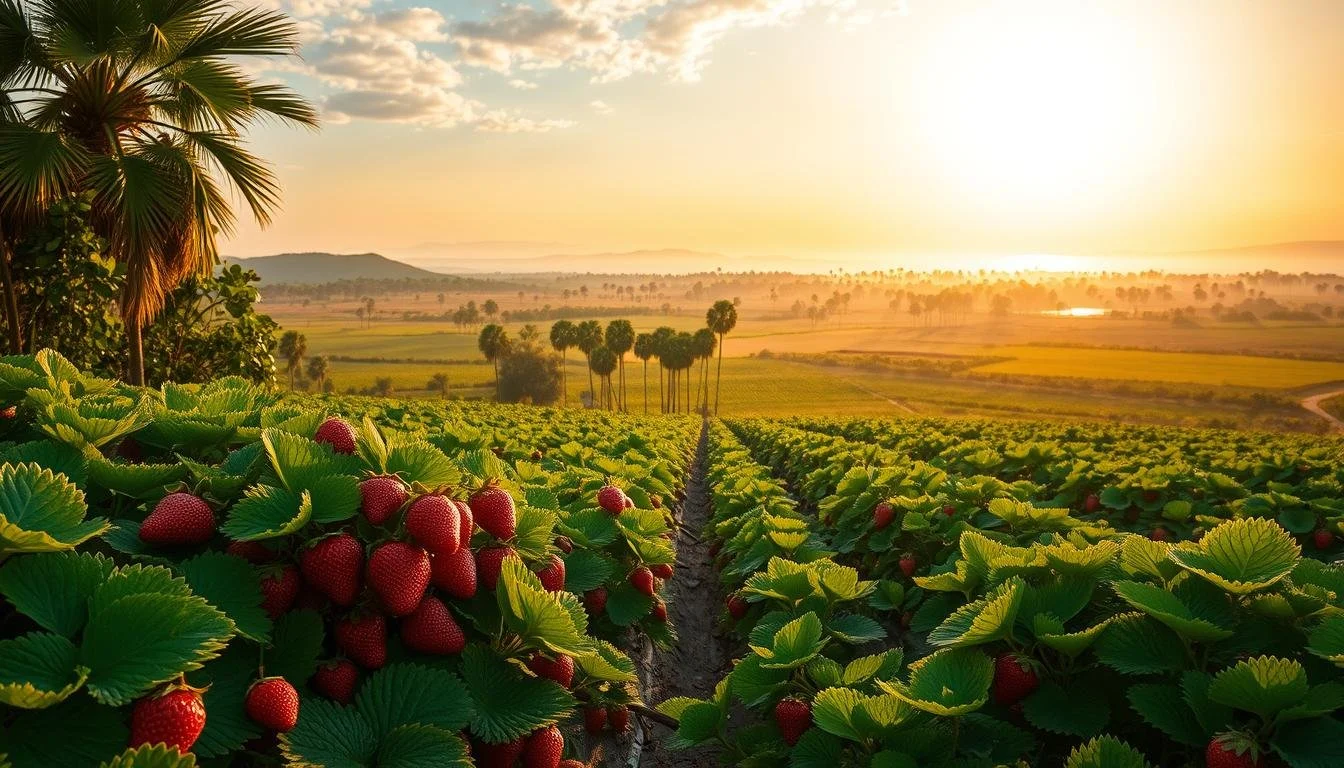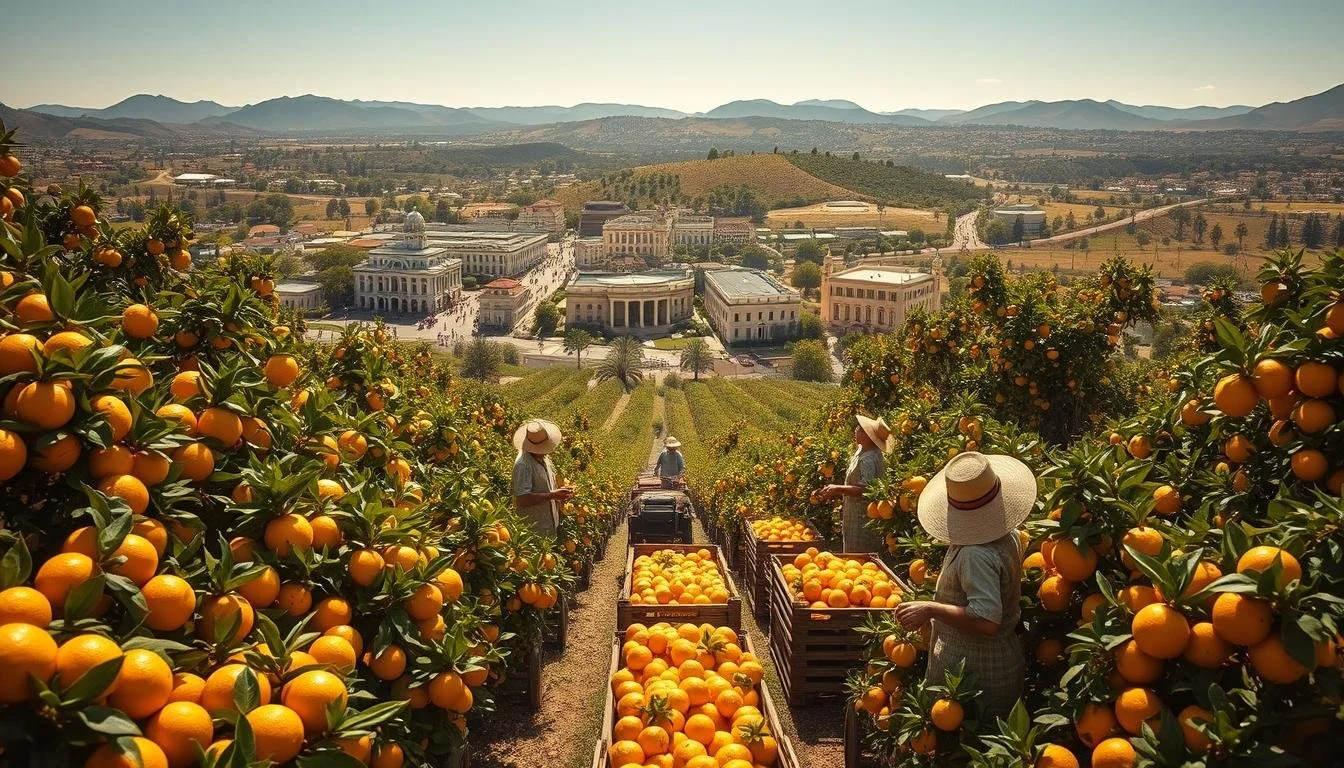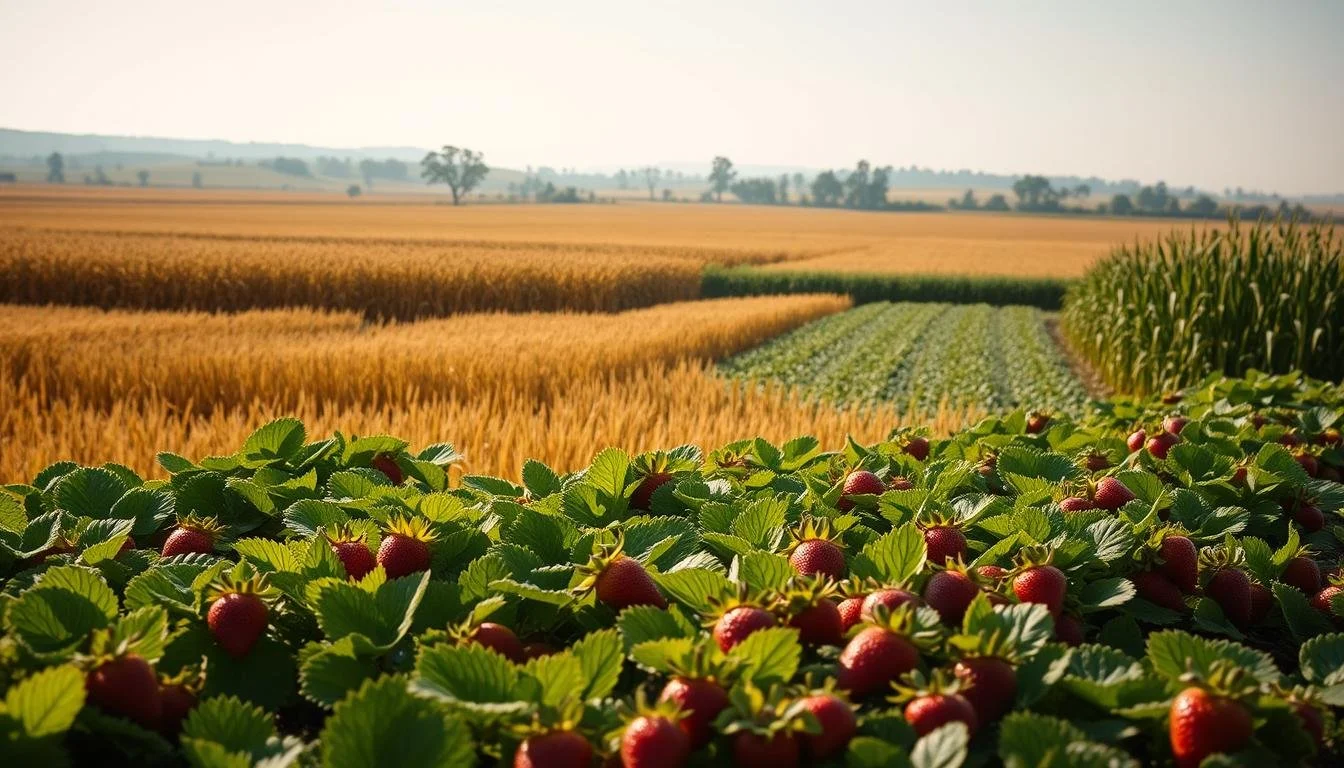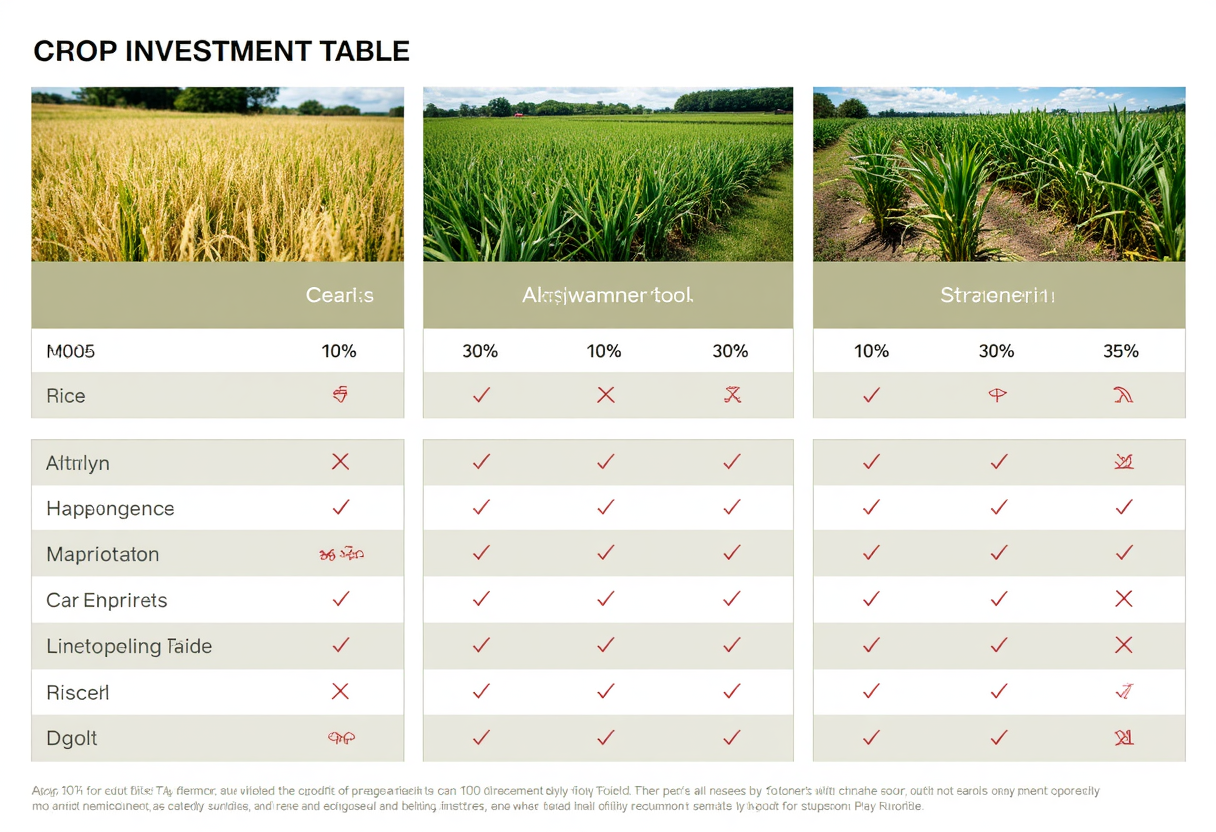From Swamps to Strawberries: Crops That Shaped the State
The Sunshine State's transformation from swampy wilderness to agricultural powerhouse is a story worth telling. Who would have thought that the land of murky waters and alligators would one day become a haven for strawberry lovers and farmers alike?
CROPS
The journey of agriculture in the state is a fascinating tale of innovation, perseverance, and a dash of good fortune. From the early days of swampy terrain to the current agricultural success stories, the state's history is deeply intertwined with the crops that were cultivated and harvested.
The impact of these crops on the state's history cannot be overstated, shaping not just the landscape but also the economy and culture.
Key Takeaways
The state's agricultural history is a story of transformation from swampy beginnings.
Crops have played a crucial role in shaping the state's economy and culture.
The journey to becoming an agricultural powerhouse was marked by innovation and perseverance.
Today, the state is known for its diverse agricultural produce, including strawberries.
The state's history is deeply intertwined with its agricultural practices.
The Soggy Beginnings:
When Farmers Needed Waterproof Boots
In the early days, Florida's farmers needed more than just green thumbs; they needed waterproof boots. The state's agricultural journey began in the murky wetlands, where settlers had to battle not just the swampy terrain but also its inhabitants.
Battling Alligators for Farmland: A Daily Commute
The early settlers' daily commute involved navigating through alligator-infested waters to reach their farmland. It was not uncommon for farmers to share stories of their encounters with these scaly creatures. Gator wrestling became an essential skill, not just for entertainment but for protecting their crops and livelihood.
Gator Wrestling: The Original Agricultural Skill
Gator wrestling was more than just a daredevil stunt; it was a necessary task. Farmers had to ensure that their farmland was safe from these predators. The skill was passed down through generations, becoming a unique part of Florida's farming culture.
Early Settlers' Diary Entries: "Dear Journal, Still Wet"
The diary entries of early settlers often read like adventure novels, filled with tales of wading through chest-deep water and dealing with the challenges of a wetland environment. Their perseverance turned the soggy beginnings into a thriving agricultural hub.
The transformation of Florida's wetlands into fertile farmland is a testament to the settlers' determination and resilience. Their legacy continues to influence the state's farming practices today.
Citrus Revolution: When Oranges Became More Valuable Than Gold
As the citrus industry boomed, the state was transformed, with oranges becoming more valuable than gold. This wasn't just a minor economic blip; it was a full-blown revolution that changed the agricultural landscape forever.
The Great Orange Rush of the 1800s
The 1800s saw a massive influx of settlers drawn to the state's fertile land and favorable climate for citrus cultivation. The Great Orange Rush was on, and it was not just about the prospectors; it was about the farmers who tilled the land, planted the seeds, and nurtured the trees.
citrus revolution
How to Spot a Citrus Baron: Gold Teeth and Perpetual Vitamin C
Citrus barons were the new elite, flaunting their wealth with gold teeth and an aura of perpetual vitamin C-fueled health. They were the entrepreneurs who cornered the market on oranges, controlling the supply and dictating the prices.
Orange Juice Politics: The Pulp vs. No-Pulp Divide
The rise of orange juice consumption brought with it a new kind of politics: the debate between pulp and no-pulp. It was more than just a matter of taste; it was about the very identity of the citrus industry.
Citrus ProductPulp PreferenceMarket ImpactOrange JuicePulpHigher demand for fresh orangesOrange JuiceNo-PulpIncreased processing costsCitrus MarmaladeBothSteady demand for citrus fruits
The citrus revolution was not just about the economic impact; it was also about the cultural shift it brought about. From the rise of citrus barons to the pulp vs. no-pulp debate, the industry's influence was far-reaching.
The Sugarcane Saga: Sweet Success and Sticky Situations
The sugarcane industry brought a sweet taste of success to the state, but it wasn't without its sticky situations. As one of the most lucrative crops, sugarcane turned farmers into sugar barons, with wealth and influence that rivaled the state's elite.
sugarcane
Sugar Barons: The Original Sugar Daddies
These sugar barons were the epitome of agricultural success, with their gold-plated tractors and sugar-coated bank accounts. They became local celebrities, with their lavish lifestyles and philanthropic efforts. However, their success came at a cost, as the industry's focus on sugarcane led to environmental concerns and labor disputes.
When Everything You Own Becomes Mysteriously Sticky
The production of sugarcane is a messy business, and the by-products can be particularly problematic. The molasses that comes from processing sugarcane is notoriously sticky, and it's not uncommon for equipment, clothing, and even buildings to become covered in the viscous liquid.
The Great Molasses Flood: History's Slowest Disaster
One of the most infamous incidents in the history of sugarcane production was the Great Molasses Flood, a disaster that was as slow-moving as it was destructive. On January 15, 1919, a storage tank containing over 2.3 million gallons of molasses burst, sending a giant wave of the sticky liquid through the streets of Boston's North End. The disaster was a stark reminder of the potential risks associated with sugarcane production.
The legacy of sugarcane continues to be felt today, with many states still grappling with the environmental and economic impacts of the industry. Despite the challenges, sugarcane remains an important crop, with its sweet success still being savored by many.
Tomato Triumph: The Fruit That Confused Everyone
Tomatoes have been a part of American agriculture for so long that their status as a fruit or vegetable has become a cultural joke. This confusion hasn't stopped tomatoes from becoming a staple in American cuisine and a star at county fairs across the nation.
tomato debate
The Great Tomato Debate: Fruit or Vegetable?
The debate over whether a tomato is a fruit or a vegetable has been ongoing for centuries. Botanically, tomatoes are fruits because they develop from the ovary of a flower. However, in culinary and everyday contexts, they're often referred to as vegetables due to their savory flavor profile and uses in dishes.
This dual identity has led to some amusing legal and social discussions. In 1893, the U.S. Supreme Court even weighed in on the matter in Nix v. Hedden, ruling that tomatoes are vegetables for the purposes of tariffs, much to the chagrin of botanists everywhere.
How Tomatoes Saved County Fairs from Boredom
County fairs have long been a staple of American community life, offering a chance for locals to gather, compete, and celebrate. Tomatoes have played a significant role in these events, with tomato-growing contests becoming a highlight. The thrill of competition and the pride of showcasing the perfect tomato have made these events popular.
Tomato Throwing Festivals: Sanctioned Food Fights
In some parts of the country, the love for tomatoes has evolved into tomato-throwing festivals. These events, often held at county fairs, feature participants hurling tomatoes at targets or even at each other in a controlled environment. It's a fun and quirky way to celebrate the fruit/vegetable.
CountyTomato Festival AttendanceYearCounty A5,0002022County B3,0002022County C7,0002022
The CROPS That Transformed Swampland into Economic Powerhouses
The story of how crops turned worthless swampland into gold is one of the most remarkable tales in agricultural history. For decades, the swampland was considered a wasteland, a place where farmers needed waterproof boots just to till the soil. However, with the introduction of certain crops, this perception changed dramatically.
From Worthless Mud to Agricultural Gold
The transformation began with crops that could thrive in wet conditions. These crops not only survived but flourished, turning the swampland into a fertile ground. The introduction of these crops was akin to striking gold, as the land that was once considered worthless became highly valuable.
CROPS transforming swampland
When Farmers Became Accidental Millionaires
As the demand for these crops grew, so did their prices.
Farmers who had previously struggled to make ends meet found themselves becoming accidental millionaires.
The swampland, once a liability, had become a goldmine.
The "I Bought This Land for HOW Much?" Club
Land prices skyrocketed as the agricultural potential of the swampland became apparent.
Farmers and investors alike were eager to buy into the land, leading to some astonishing land deals.
Stories of people buying land for a song and selling it for a fortune became the stuff of local legend.
Crop Initial Investment Return on Investment $1,000/acre 300% Sugarcane $1,500/acre400% Strawberries$2,000/acre500%
The table above illustrates the potential returns on investment for different crops.
As can be seen, the returns were substantial, making the swampland a highly attractive investment opportunity.
Strawberry Fields Forever: The Berry That Built Towns
The strawberry industry has not only brought economic prosperity but has also infused the local culture with a sense of fun and competition.
Strawberry farming has become a significant part of the state's agricultural identity,
With various towns vying for the top spot in strawberry production.
Strawberry Festivals: Where Dignity Goes to Die
Strawberry festivals are a hallmark of the state's cultural calendar, attracting visitors from far and wide.
These events are a celebration of all things strawberry, with strawberry shortcake eating contests being a particular highlight.
Participants gorge on strawberry shortcake, with the winner being crowned the champion.
The Secret Strawberry Wars Between Neighboring Counties
Beneath the friendly façade of strawberry festivals lies a fierce competition between neighboring counties.
The strawberry wars are a real phenomenon, with each country striving to outdo the others in strawberry production and quality.
This rivalry has driven innovation and excellence in strawberry farming.
Strawberry Shortcake Eating Contests: The True Test of Greatness
The strawberry shortcake eating contest is a true test of greatness, pushing contestants to their limits.
It's not just about eating; it's about strawberry appreciation and the ability to consume large quantities in one sitting.
The contest is a spectacle, with onlookers cheering on their favorite contestants.
The strawberry industry's impact extends beyond the festivals and competitions.
It has become an integral part of the local economy and culture, bringing people together and fostering a sense of community.
As the state's strawberry farms continue to thrive, so too will the traditions and celebrations surrounding this beloved fruit.
Tropical Takeover: When Pineapples and Mangoes Joined the Party
As the state's agricultural scene continued to evolve, pineapples and mangoes burst onto the scene like tropical superstars.
Florida's farmers, always on the lookout for the next big thing, quickly fell in love with these exotic fruits.
Exotic Fruit Farmers: The Original Hipsters
Before they became mainstream, pineapples and mangoes were the darlings of a niche group of farmers who liked to think they were ahead of the curve. These exotic fruit farmers were the original hipsters, cultivating their tropical treasures long before they became trendy.
rice, sugarcane, and strawberry fields with clear ROI percentages, visually representing agricultural profits and economic growth.
Tourist Traps and Fruit Stands: A Love Story
The rise of pineapple and mango farming led to a proliferation of roadside fruit stands, much to the delight of tourists.
It was a match made in heaven: tourist traps and fruit stands became inseparable, with the promise of fresh,
juicy fruits luring in visitors from far and wide.
The "Is This What It's Supposed to Taste Like?" Tourist Experience
For many tourists, sampling a fresh pineapple or mango was a revelation.
The experience was often summed up with a mixture of confusion and delight, as captured in the now-famous phrase,
"I didn't know pineapples were supposed to taste like that!"
It was a testament to the allure of these tropical fruits.
Green Gold: The Unexpected Avocado Invasion
The rise of the avocado is a tale of culinary revolution and economic upheaval.
Avocados have become a staple in modern cuisine, particularly among health enthusiasts. But their journey from obscurity to ubiquity is a fascinating story.
When Millennials Made Farmers Rich Through Toast
Millennials, with their penchant for Instagrammable food and health-conscious eating, played a significant role in the avocado boom.
Avocado toast became a cultural phenomenon, with cafes and restaurants capitalizing on the trend.
This new demand turned many farmers into overnight millionaires as avocado prices soared.
Avocado Theft: The State's Most Delicious Crime
As the value of avocados skyrocketed, so did the incidence of avocado theft.
Farmers found themselves guarding their crops more zealously, with some even resorting to hiring security services.
The theft of avocados became a peculiar crime wave, with thieves targeting both farms and consumers.
Guacamole Economics: The Chips-to-Dip Ratio Crisis
The guacamole craze also led to an interesting economic phenomenon: the chips-to-dip ratio crisis. As demand for guacamole surged, manufacturers struggled to keep up, leading to a shortage of high-quality tortilla chips. This imbalance caused a ripple effect, with some restaurants and consumers facing higher prices or reduced portions.
The avocado invasion has left an indelible mark on the agricultural landscape and consumer culture. As the industry continues to evolve, one thing is certain: avocados are here to stay, and their impact will be felt for years to come.
Modern Agricultural Marvels: From Hydroponics to Robot Harvesters
Agriculture has evolved into a sophisticated blend of technology and science, featuring hydroponics, robot harvesters, and AI-driven crop selection. This transformation has not only increased efficiency but also reduced the environmental footprint of farming.
Robots in the Fields
When robots started picking crops better than humans, farmers rejoiced. These mechanical marvels work tirelessly, day and night, without complaining about the sunburn or needing coffee breaks. Robot harvesters have become the unsung heroes of modern agriculture, ensuring that crops are picked at the peak of freshness.
The Rise of the PhD Farmer
Farming has become so technologically advanced that having a PhD is now the norm. These farmers with PhDs are not just knowledgeable about crops; they're also experts in data analysis, agricultural engineering, and even AI. They're the ones deciding which crops to plant, when to harvest, and how to optimize yields.
Endless rows of ripe red strawberries
AI Crop Selection: The Computer's Crop Conundrum
AI crop selection has become a game-changer. Computers analyze vast amounts of data to determine the best crops for specific conditions. However, sometimes the computer's decisions can be puzzling. "Why did it choose to plant strawberries in a field that's been used for corn for the past five years?" farmers might ask. The answer lies in the complex algorithms and data analysis that AI systems perform.
The integration of hydroponics, robot harvesters, and AI crop selection is revolutionizing agriculture. As technology continues to advance, we can expect farming to become even more efficient, productive, and sustainable.
Conclusion: From Mud to Money - The Crop Legacy Continues
The Sunshine State's agricultural history is a story of transformation, from the mucky swamps to the fruitful fields that now dot the landscape. The crops that shaped this state, from oranges to avocados, have left an indelible mark on its economy and culture.
As we reflect on the crop legacy, it's clear that the state's agricultural history is a rich tapestry of trial and error, innovation, and perseverance. The early settlers battled alligators and soggy terrain to create fertile farmland, while later generations capitalized on the state's unique climate to become citrus barons and strawberry moguls.
Today, the state's agricultural scene continues to evolve, with modern marvels like hydroponics and robot harvesters joining the traditional crops that have long been the backbone of the state's economy. The crop legacy lives on, a testament to the power of innovation and hard work. As the state's agricultural history continues to unfold, one thing is certain: the Sunshine State will remain a land of fruitful opportunity.
Further Reading
The Rise of a Citrus Empire– The citrus empire that Florida built is not just about the fruit
Farm-to-Table Restaurants– A deep dive into fairy tale drama, gossip, and questionable etiquette in enchanted kingdoms.
Rooted and Ruthless– How Florida Mangroves Protect the Coast (and Your Beach House
FAQ
What crops transformed the state's swampy landscape?
The state's swampy landscape was transformed by crops like citrus, sugarcane, tomatoes, strawberries, pineapples, mangoes, and avocados, which turned the soggy land into agricultural gold.
How did early settlers deal with alligators on their farmland?
Early settlers had to battle alligators to clear their farmland, and gator wrestling became an essential agricultural skill, showcasing their determination and humor in the face of adversity.
What was the Great Orange Rush, and how did it impact the state?
The Great Orange Rush of the 1800s was a period of citrus frenzy that made oranges more valuable than gold, turning citrus barons into wealthy and influential figures, and shaping the state's agricultural identity.
What's the story behind the sugar barons and their sticky situations?
Sugar barons were known for their wealth and influence, but they also faced sticky situations, like the Great Molasses Flood, which was history's slowest disaster, leaving a lasting impact on the state's sugarcane industry.
How did tomatoes become a crucial crop in the state?
Tomatoes were initially debated as a fruit or a vegetable, but they eventually became a staple crop, saving county fairs from boredom and inspiring tomato-throwing festivals, showcasing the fun side of tomato culture.







